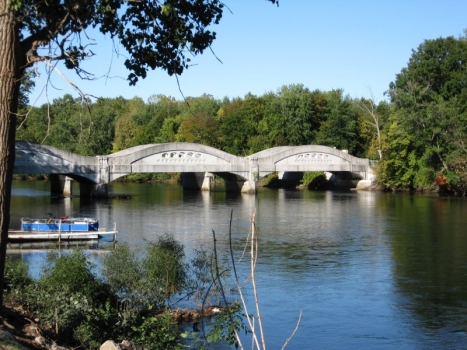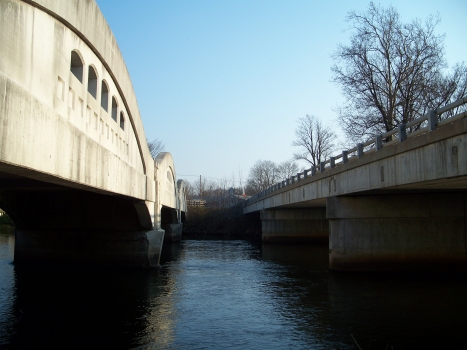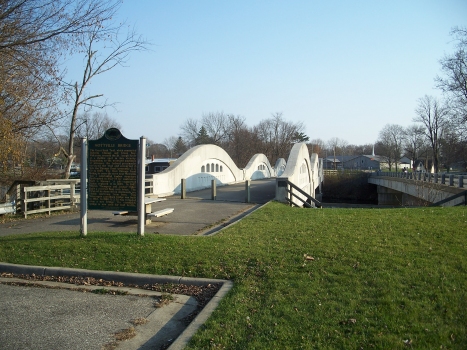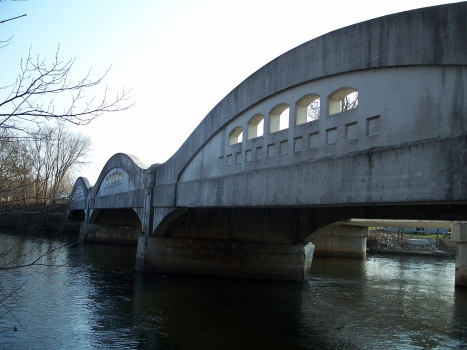General Information
| Other name(s): | US 12–St. Joseph River Bridge |
|---|---|
| Completion: | 1922 |
| Status: | in use |
Project Type
| Material: |
Reinforced concrete bridge |
|---|---|
| Structure: |
Haunched girder bridge |
| Material: |
Structurae Plus/Pro - Subscribe Now! |
| Function / usage: |
original use: Road bridge current use: Bicycle and pedestrian bridge |
Location
| Location: |
Mottville Township, Saint Joseph County, Michigan, USA |
|---|---|
| Coordinates: | 41° 48' 0.38" N 85° 45' 25.14" W |
Technical Information
Dimensions
| main span | 27.40 m | |
| total length | 82.30 m | |
| deck width | 11.00 m |
Materials
| superstructure |
reinforced concrete
|
|---|---|
| piers |
reinforced concrete
|
Excerpt from Wikipedia
The US 12–St. Joseph River Bridge is a three-span camelback bridge in Mottville, Michigan, that carried U.S. Route 12 across the St. Joseph River. Built in 1922, it is the fourth bridge to cross the river at this location. It has served as a pedestrian bridge since 1990 when a new bridge opened alongside to carry the highway. The bridge is the longest surviving camelback bridge in Michigan. It is a Michigan State Historic Site and is listed on the National Register of Historic Places.
History
The US 12–St. Joseph River Bridge is the fourth bridge to cross the St. Joseph river in this vicinity. The Great Sauk Trail crossed the river at a shallow spot near the modern crossing. In 1825, the trail was surveyed and converted by the federal government into the Chicago Road, which presently is US 12. The first bridge to carry this road was a timber structure built from 1833 through 1834. Ist replacement, a pile-supported bridge, was built in 1845. A covered Burr arch truss was then built in 1867, of which the ruins of ist abutments remain. The former covered bridge (285 feet [87 m] long and 25 feet [7.6 m] wide) was sold at auctions to Ray Berger, a farmer who used the wood to build a barn in 1927. The camelback bridge was constructed in 1922, with Smith and Nichols of Hastings, Michigan, as contractor.
The bridge was designated a Michigan State Historic Site on April 10, 1986, and an informational marker was erected on October 31, 1989. In 1990, the bridge was relegated to pedestrian traffic when a new bridge adjacent to the historic span opened to carry US 12. Instead of demolishing the structure, the Michigan Department of Transportation preserved it as an engineering landmark. On April 5, 1991, the bridge was added to the National Register of Historic Places.
Design
The bridge was built from standardized plans developed by the Michigan State Highway Department by the early 1920s. It is located at the western edge of the Village of Mottville. At 270 feet (82 m) in length, it is the longest surviving camelback bridge in Michigan. It consists of three identical, 90-foot (27 m) spans built of reinforced concrete, supported by concrete piers and abutments. Reinforced steel girders form ist arches. Each arch has five openings above a row of recesses for decorative effect.
Text imported from Wikipedia article "US 12–St. Joseph River Bridge" and modified on April 11, 2020 according to the CC-BY-SA 4.0 International license.
Participants
Currently there is no information available about persons or companies having participated in this project.
Relevant Web Sites
- About this
data sheet - Structure-ID
20078955 - Published on:
01/01/2020 - Last updated on:
05/08/2020









